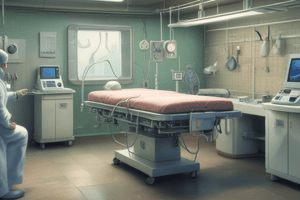Podcast
Questions and Answers
Which type of radiation sterilization is best for medical supplies?
Which type of radiation sterilization is best for medical supplies?
- UV Radiation
- Non-Ionizing Radiation
- Infrared Radiation
- Ionizing Radiation (correct)
What is a significant limitation of chemical sterilization using formaldehyde?
What is a significant limitation of chemical sterilization using formaldehyde?
- It is ineffective against spores.
- It is only effective in gas form.
- It cannot penetrate packaging.
- It has potential toxicity and safety concerns. (correct)
What is the primary advantage of filtration sterilization?
What is the primary advantage of filtration sterilization?
- It eliminates the need for sterile techniques.
- It is effective for heat-sensitive solutions. (correct)
- It is suitable for all types of microorganisms.
- It can remove viruses effectively.
What temperature is commonly used in autoclaving for effective sterilization?
What temperature is commonly used in autoclaving for effective sterilization?
What is a key characteristic of non-ionizing radiation sterilization?
What is a key characteristic of non-ionizing radiation sterilization?
Which method of sterilization is least effective against bacterial spores?
Which method of sterilization is least effective against bacterial spores?
In dry heat sterilization, which mechanism is primarily responsible for microbial destruction?
In dry heat sterilization, which mechanism is primarily responsible for microbial destruction?
What type of sterilization is ethylene oxide gas primarily used for?
What type of sterilization is ethylene oxide gas primarily used for?
What safety concern is associated with radiation sterilization?
What safety concern is associated with radiation sterilization?
Which of the following is a characteristic of steam sterilization (autoclaving)?
Which of the following is a characteristic of steam sterilization (autoclaving)?
Flashcards are hidden until you start studying
Study Notes
Methods of Sterilization
Filtration Sterilization
- Definition: A method that uses filters to remove microorganisms from liquids or gases.
- Mechanism:
- Membrane filters (0.2-0.45 micrometers) trap bacteria and larger pathogens.
- Useful for heat-sensitive solutions like vaccines or culture media.
- Limitations: Ineffective against viruses or smaller microorganisms; requires sterile technique to avoid recontamination.
Radiation Sterilization
- Types:
- Ionizing Radiation: Uses gamma rays or X-rays to disrupt DNA. Effective for medical supplies and pharmaceuticals.
- Non-Ionizing Radiation: Uses UV light to damage microbial DNA. Common for surfaces and air sterilization.
- Advantages: Effective against a wide range of pathogens; no residual chemicals.
- Limitations: Requires specialized equipment and safety precautions due to radiation exposure.
Chemical Sterilization
- Common Agents:
- Ethylene oxide: Gas used for heat-sensitive items. Effective and penetrates packaging.
- Hydrogen peroxide: Vaporized or liquid form, effective against bacteria, viruses, and spores.
- Formaldehyde: Used in gas or liquid form; potent but with safety concerns.
- Applications: Suitable for instruments, medical equipment, and some surfaces.
- Limitations: Requires careful handling; potential toxicity and residual effects.
Autoclaving
- Process: Uses steam under pressure to achieve high temperatures (typically 121°C or 134°C).
- Mechanism: Moist heat denatures proteins and disrupts cellular structures.
- Advantages: Highly effective against all forms of microorganisms, including spores.
- Limitations: Not suitable for heat-sensitive materials; requires specific time and pressure parameters for effectiveness.
Dry Heat Sterilization
- Process: Involves exposure to hot air (160-180°C) for an extended time.
- Mechanism: Destroys microorganisms through oxidation and dehydration.
- Applications: Ideal for glassware, metal instruments, and powders.
- Advantages: Does not corrode instruments; effective for certain items.
- Limitations: Longer duration compared to moist heat; less effective against spores unless used at higher temperatures.
Filtration Sterilization
- Uses filters to eliminate microorganisms from liquids or gases.
- Membrane filters range from 0.2 to 0.45 micrometers, capturing bacteria and larger pathogens.
- Particularly effective for preserving heat-sensitive solutions, such as vaccines and culture media.
- Ineffective against smaller microorganisms, like viruses; requires strict sterile techniques to avoid contamination.
Radiation Sterilization
- Ionizing Radiation: Employs gamma rays or X-rays, interrupting DNA, making it suitable for sterilizing medical supplies and pharmaceuticals.
- Non-Ionizing Radiation: Utilizes UV light to harm microbial DNA, commonly used for sanitizing surfaces and air.
- Advantages include effectiveness against diverse pathogens without leaving chemical residues.
- Limitations involve needing specialized equipment and implementing safety measures due to radiation risks.
Chemical Sterilization
- Common Agents:
- Ethylene oxide: A gas effective for heat-sensitive items, with good penetration through packaging.
- Hydrogen peroxide: Available in vapor or liquid form, it is effective against bacteria, viruses, and spores.
- Formaldehyde: Can be used as gas or liquid; effective but raises safety concerns.
- Suitable for sterilizing instruments, medical equipment, and some surfaces.
- Requires careful handling due to potential toxicity and lingering residual effects.
Autoclaving
- Relies on steam under pressure to reach high temperatures, typically at 121°C or 134°C.
- Moist heat effectively denatures proteins and alters cellular structures, ensuring broad microbial destruction.
- Highly effective against all microorganisms, including spores.
- Not appropriate for heat-sensitive materials; specific time and pressure settings are crucial for efficacy.
Dry Heat Sterilization
- Involves prolonged exposure to hot air, typically at temperatures between 160-180°C.
- Mechanism focuses on oxidation and dehydration to destroy microorganisms.
- Particularly suitable for glassware, metal instruments, and powders.
- Advantages include non-corrosiveness to instruments and effectiveness for particular items.
- Drawbacks include longer processing times necessary compared to moist heat and reduced effectiveness against spores at lower temperatures.
Studying That Suits You
Use AI to generate personalized quizzes and flashcards to suit your learning preferences.




